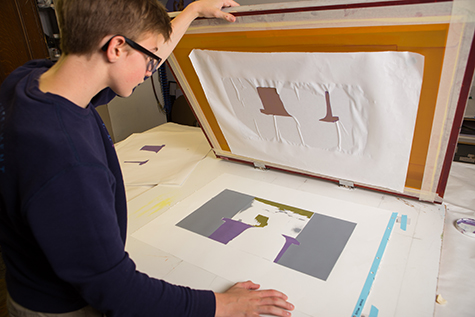ChatGPT said: How 10:9 Design Screen Printing can elevate your brand
The Essential Guide to Recognizing Screen Printing and Its Versatile Uses
Screen printing has an abundant history that goes back to ancient times, advancing right into an innovative strategy made use of throughout various sectors today. This guide discovers the intricacies of the screen printing procedure, describing its applications in advertising and marketing, fashion, and home decoration - 10:9 Design Screen Printing Texas. Comprehending these principles can open innovative potential for both commercial and artistic tasks. The following areas will certainly reveal essential pointers and strategies to improve one's screen printing endeavors
The Background of Screen Printing
Although screen printing has roots that map back centuries, its evolution reflects the technological and creative developments of various societies. Coming from old China, the method was initially used for decorating textiles and later infect Japan, where it ended up being integral to Ukiyo-e woodblock printing. The technique shifted to Europe in the 18th century, where it gained popularity among craftsmens and industrial printers. The invention of picture emulsion in the 20th century transformed screen printing, allowing for more detailed styles and higher effectiveness. Musicians like Andy Warhol additionally pushed its appeal, utilizing the medium to develop renowned jobs that mixed commercialism and great art. By the late 20th century, screen printing had developed itself as a versatile method, used in vogue, marketing, and art. Today, it remains to develop, integrating digital modern technology and increasing its applications across numerous sectors.
The Screen Printing Refine Explained
Screen printing transforms creative visions into tangible styles via a series of accurate steps. Initially, a picture is produced and afterwards transferred onto a screen, typically constructed from fine mesh textile extended over a frame. A light-sensitive emulsion is used to the screen, which is revealed to light, solidifying in locations not covered by the picture. After washing out the unhardened emulsion, a stencil is created.
Next, the screen is put over the substrate, whether it be material, paper, or one more product. Ink is after that pushed with the open locations of the pattern making use of a squeegee, depositing the design onto the substrate below. This process can be repeated for numerous colors, needing separate displays for each tone. The published product is cured using warm to guarantee the ink adheres effectively, resulting in a resilient, vivid style ready for use.
Kinds Of Screen Printing Techniques

In addition, specialized techniques, such as discharge screen printing, eliminate color from the fabric to produce softer prints, while aluminum foil screen printing uses metallic foil to achieve a shiny finish (10:9 Design reviews). Each technique supplies distinct characteristics, dealing with numerous imaginative needs and production ranges, eventually expanding the Get More Info opportunities within the screen printing domain
Applications of Screen Printing in Numerous Industries

Furthermore, the signage and advertising and marketing fields Clicking Here utilize screen printing for developing attractive screens and banners. This technique permits bold colors and intricate designs that capture attention. In electronic devices, screen printing is utilized for using conductive inks to circuit card, essential for part links. The home design sector welcomes screen printing to produce distinctive layouts on fabrics and wall surface art. In general, screen printing acts as an important tool throughout diverse fields, enhancing items with individualized and aesthetically appealing graphics.
Tips for Effective Screen Printing Projects
While undertaking a screen printing project, careful focus to information can significantly improve the last end result. Selecting top quality products is important; this consists of the screen, inks, and substrates. Utilizing proper mesh matters can impact ink deposition and information resolution. Preparation is similarly essential; detailed cleansing of displays and appropriate exposure times guarantee crisp prints.
Next, precise registration is vital for multi-color prints. Using alignment tools can aid attain exact layering. In addition, screening prints on scrap materials prior to manufacturing aids determine potential issues without squandering resources.

Regularly Asked Concerns
What Products Are Finest for Screen Printing on Fabric?
Cotton and polyester blends are ideal for screen printing on textile as a result of their toughness and ink absorption. Furthermore, specialty textiles like silk or canvas can generate special textures and coatings, improving the overall layout high quality.
How Do I Tidy and Maintain Screen Printing Devices?
To clean and preserve screen printing tools, one must regularly wash displays with suitable solvents, inspect mops for wear, lubricate relocating parts, and shop all items in a completely dry, dust-free environment to lengthen their lifespan.
What Are the Ecological Influences of Screen Printing?
Screen printing can have substantial environmental influences, including chemical waste from inks and solvents, water use during cleansing procedures, and energy intake. Sustainable techniques and green materials are essential for lessening these adverse effects.
Can Screen Printing Be Done in the house Effectively?
Screen printing can be successfully done at home with the appropriate materials and methods. Enthusiasts can develop quality prints, though success depends upon their skill degree, tools, and understanding of the procedure included.
What Are the Prices Linked With Starting a Screen Printing Company?

Starting a screen printing service entails expenses for devices, materials, and work area. Initial expenses typically range from a couple of hundred to numerous thousand bucks, depending upon the scale, quality of equipment, and preferred production capability.
Screen printing has a rich history that dates back to old times, progressing into a sophisticated strategy utilized across various industries today. An additional method, rotary screen printing, uses cylindrical screens, assisting in continual printing on material rolls, thus boosting effectiveness for massive productions. In addition, specialty strategies, such as discharge screen printing, remove dye from the fabric to produce softer prints, while foil screen printing uses metal foil to attain a shiny finish. In the style sector, screen printing is extensively made use of to create vibrant designs on apparel, enabling brands to showcase their distinct styles. Cotton and polyester blends are perfect for screen printing on material due to their resilience and ink absorption.